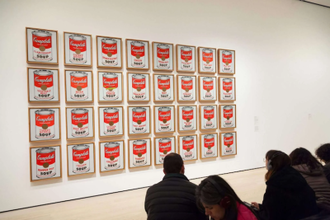Gospel in Art: Do not work for food that perishes, but for food that endures

Campbell's Soup Cans, by Andy Warhol, 1962 © Alamy stock photo / Edward Westmacott / Museum of Modern Art, New York
Source: Christian Art
Gospel of 5 May 2025
John 6:22-29
After Jesus had fed the five thousand, the disciples saw him walking on the lake. On the next day the crowd that remained on the other side of the lake saw that there had been only one boat there, and that Jesus had not entered the boat with his disciples, but that his disciples had gone away alone. Other boats from Tiberias came near the place where they had eaten the bread after the Lord had given thanks. So when the crowd saw that Jesus was not there, nor his disciples, they themselves got into the boats and went to Capernaum, seeking Jesus.
When they found him on the other side of the lake, they said to him, 'Rabbi, when did you come here?' Jesus answered them, 'Truly, truly, I say to you, you are seeking me, not because you saw signs, but because you ate your fill of the loaves. Do not work for the food that perishes, but for the food that endures to eternal life, which the Son of Man will give to you. For on him God the Father has set his seal.' Then they said to him, 'What must we do, to be doing the works of God?' Jesus answered them, 'This is the work of God, that you believe in him whom he has sent.'
Reflection on the Pop Art Paintings
It is just over sixty years since Andy Warhol created his iconic series of 32 canvases depicting Campbell's soup cans. In 1962, this work was seen as avant-garde and boldly visionary, though many - both then and now - have questioned whether it can truly be called art. Yet, there is no doubt that Warhol's work pushed the boundaries of modern art in a unique and provocative way, securing its place as one of the quintessential artistic statements of the 20th century. When asked why he chose to paint something as ordinary as soup cans, Warhol's answer was disarmingly simple: "I used to have the same lunch every day, for twenty years, I guess, the same thing over and over again." His focus on the repetition of daily life speaks volumes about modern consumer culture. But in today's Gospel, Jesus speaks of a very different kind of daily meal: one not rooted in consumption, but in life-giving sustenance.
Jesus speaks of two kinds of food: the food that perishes and the food that endures to eternal life. He doesn't dismiss the importance of daily, physical nourishment. After all, He fed the hungry crowds, cared for the poor, and responded to human need with compassion. The physical well-being of people mattered deeply to Him. Yet, having satisfied those basic needs, Jesus invites us to look deeper: to recognise a hunger that bread alone cannot satisfy. This is the hunger of the soul, a longing for meaning, for love, for God Himself. And it is a hunger that only Christ can truly fulfil.
The daily meal that Jesus offers us is the Eucharist, the true bread from heaven, the centre of our faith and the answer to our deepest spiritual hunger. In receiving this gift, we are not only nourished, but transformed! The Eucharist does more than simply sustain us; it shapes how we see others. It calls us to go beyond simply meeting people's material needs (important though they are). Feeding the poor and feeding ourselves spiritually go hand in hand. Through the sacred meal of the Eucharist, we also learn to relate to others not just for what they lack, but for who they are: brothers and sisters in Christ, worthy of dignity, love, and communion.
While Andy Warhol famously spoke of his routine of eating Campbell's soup every day, reducing daily nourishment to a simple, repetitive act, there was a deeper side to his daily habits that is less well known. Warhol was a daily Mass-goer, quietly attending services throughout his life, despite his public image as a leading figure of the avant-garde art world. He attended St. Vincent Ferrer Church in New York City, a Dominican parish near his home, where he would slip in without drawing attention. This reveals that Warhol understood the importance of nurturing not just the body, but also the soul. Beyond the superficial routine of his physical diet, he sought spiritual sustenance in the Mass, recognising, perhaps in his own quiet way, that true nourishment comes from more than what we consume outwardly.
LINKS
Gospel in Art: https://christian.art/
Today's Reflection: https://christian.art/daily-gospel-reading/john-6-22-29-2025/ (with audio)

















